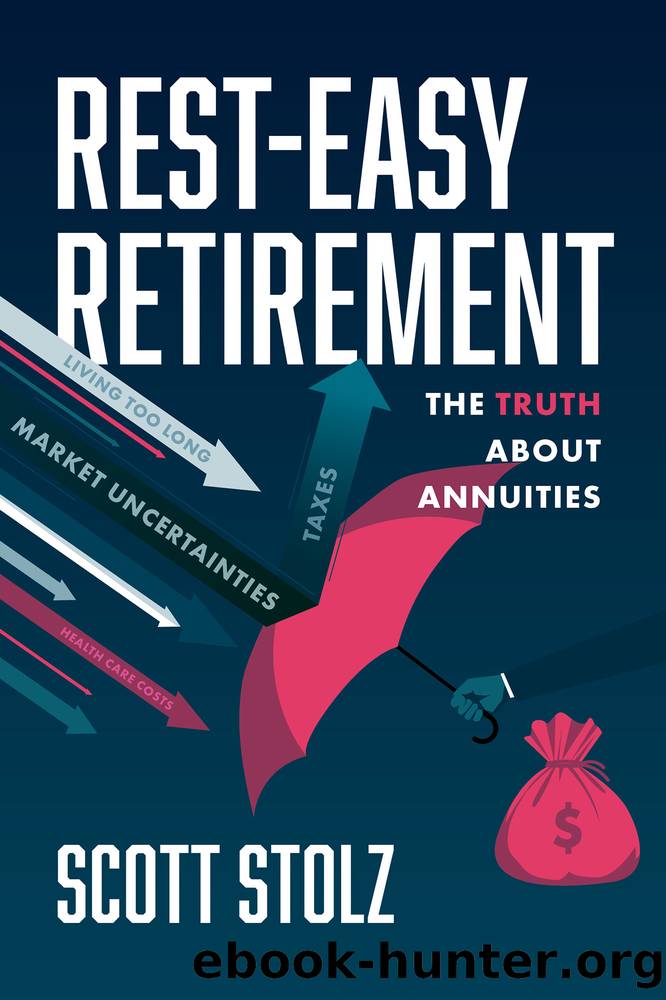Rest-Easy Retirement by Stolz Scott;

Author:Stolz, Scott; [Stolz, Scott]
Language: eng
Format: epub
Tags: General Fiction
ISBN: 9781642254235
Publisher: Advantage Media Group
Published: 0101-01-01T00:00:00+00:00
INTERPRETING THE ABOVE CHART
The Best Return
This number is simply the best return you can get in any one year. Since all three options have a cap, the best return is equal to that cap. If we look at only this criteria, we would take the 10 percent buffer with the 20 percent cap in order to capture the highest possible return. But remember, the more the upside potential, the greater the potential downside. Therefore, we need more information to make the best choice.
The Average Return
This is the return if we average the returns that would have been experienced in every one-year period back to 1953, assuming the cap rates listed above never changed from year to year and the stock marketâs performance is similar to how it has performed historically. In reality, the cap rates will change over time, but our goal in this example is simply to give you some indication of what to expect over time. Once again, due to the 8.7 percent average return, it appears as though the 10% percent buffer with the 20% percent cap is the superior option.
The Worst
This is the single worst one-year return over every one-year period after the buffer or floor is applied. All the sudden, the 20 percent cap with the 10 percent buffer doesnât look so good. Had you employed this strategy during the financial crises of 2007â09, you would have had a one-year period where the index was down 48.82 percent, leaving you with a loss of 38.82 percent after the buffer. And while the 20 percent buffer would have helped a bit, it would have only protected another 10 percent, thereby leaving you with a loss of 28.82 percent. Under these extreme conditions, the floor option shines. Since it protects you from any loss beyond the floor percent, you would have only experienced a loss of 10 percent.
Positive
This number gives you the percentage of times you would have experienced a positive return in a given year. If you remember, I have previously said that the market goes up on average about three out of every four years. This number proves that point. If we look at every one-year period since 1953, the S&P 500 increased in value 73.22 percent of the time. This means no matter which of these three options you select, you should expect to receive a positive return of 73.22 percent.
Zero
This number represents the percentage of time you would have historically received no interest in a year. You will note that for the 10 percent floor option, this occurs only in the years where the S&P 500 ends a year exactly where it started. Historically, that has happened only 0.02 percent of the timeâor pretty much never. For the 10 percent buffer/20 percent cap, it has historically occurred during 14.21 percent of the total one-year periods. In other words, the index was down for the year, but by no more than 10 percent. When we move up to the 20 percent buffer, we are
Download
This site does not store any files on its server. We only index and link to content provided by other sites. Please contact the content providers to delete copyright contents if any and email us, we'll remove relevant links or contents immediately.
| Corporate Finance | Crowdfunding |
| Financial Engineering | Financial Risk Management |
| Wealth Management |
The Black Swan by Nassim Nicholas Taleb(6205)
Bad Blood by John Carreyrou(5784)
Pioneering Portfolio Management by David F. Swensen(5617)
Millionaire: The Philanderer, Gambler, and Duelist Who Invented Modern Finance by Janet Gleeson(3576)
Skin in the Game by Nassim Nicholas Taleb(3484)
The Money Culture by Michael Lewis(3293)
Skin in the Game: Hidden Asymmetries in Daily Life by Nassim Nicholas Taleb(3275)
Bullshit Jobs by David Graeber(3192)
The Wisdom of Finance by Mihir Desai(3088)
Blockchain Basics by Daniel Drescher(2899)
Liar's Poker by Michael Lewis(2822)
The Intelligent Investor by Benjamin Graham Jason Zweig(2603)
Hands-On Machine Learning for Algorithmic Trading by Stefan Jansen(2545)
Mastering Bitcoin: Programming the Open Blockchain by Andreas M. Antonopoulos(2523)
Investing For Dummies by Eric Tyson(2479)
Fooled by Randomness: The Hidden Role of Chance in Life and in the Markets by Nassim Nicholas Taleb(2423)
The Power of Broke by Daymond John(2381)
Zero Hour by Harry S. Dent Jr. & Andrew Pancholi(2253)
Market Wizards by Jack D. Schwager(2172)
